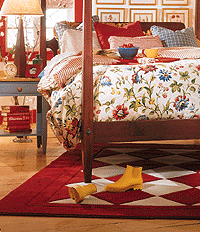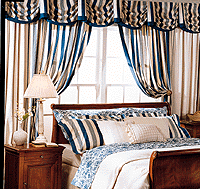Mastering the basics

Color is
the most fundamental feature of a room. With
a few strokes of a brush, you can literally
change the look and mood of a room. Paint is
simply the most flexible and basic design tool
you can use. wall color Some variation of white is the
most livable color. The two basic types are: warm
white (yellow undertone) or cool white (gray or
blue undertones). To brighten a room that
receives little or no direct sunlight, apply a
warm white. To balance a very sunny room, apply a
cool white. Warm whites or pastel whites work
well in private spaces, like bedrooms and baths.
If you want to be a bit daring, why not try a
color you really love? Paint color is inexpensive
and easy to change. ceiling color To “heighten” a room,
paint the ceiling white or a lighter shade of the
wall color. trim
color For ease
of cleaning, paint baseboards and moldings in
glossy, oil- based paint. To stress the
architectural features of a room, paint
baseboards and moldings in glossy white.
| decorator’s
secret Choosing
a Wall Color:
The only surefire way to choose the
right color is to apply a patch of the
paint onto your wall. Be sure that the
paint patch covers at least one square
foot. Live with it for a few days, and
look at it under natural and artificial
light.
|
lighting

Lighting. Don’t wait till the end to
choose lighting. Assess your lighting needs for
each room as part of your general decorating
plan. Some rooms require bright, general
lighting, while others need only a few accent
lights. mood Ceiling lights are not
necessarily the best lighting in large rooms. In
living rooms, wall sconces often provide a more
flattering glow than overhead lights. In
bedrooms, table and floor lamps offer soft, warm
lighting. Bright fluorescent lighting is great
for work areas like kitchens, home offices and
garages. Never use fluorescent lights in the
bedroom. Halogen light is unbeatable for
brightness, but for safety reasons, be careful
about where it is placed. Tame
the brightness with a dimmer.
| decorator’s
secret Unleashing
Bold Colors:
If you’ve always dreamed of
having a red room but you’re unsure
about making such a big statement;
don’t deny yourself! Certain rooms
lend themselves to bold color. For a
dramatic dining room or study, try
evergreen, apple red or indigo blue. Bold
colors also add interest and humor to
small spaces (try a bathroom in sea blue
or a pantry in a melon shade).
|
Flooring

Flooring. It can be the quiet backdrop for
furniture and accessories, or it can dominate the
room as the major decorative element. But
don’t be ruled by looks alone: Always keep
ease of maintenance in mind.wood For versatility and style,
nothing beats polished wood floors. For real
charm, consider stenciled or painted wood floors
(also great for hiding imperfections on the floor
surface).
carpet Adaptable
to traditional and modern decor, a well-made
Oriental rug can last for decades. Generally,
large rugs in a neutral tone can
“enlarge” a room. Wall-to-wall
carpeting provides warmth and uniformity (great
for bedrooms and formal living rooms).tile Stone or tile flooring is sleek
and easy to maintain (perfect for entries,
kitchens, baths &ndash areas that may get
wet).
| decorator’s
secret Creating
a Color Palette:
Ideally, the rug should be acquired
before the furniture. Then you can create
the color scheme for the room based on
the various colors in the rug. To ensure
that the upholstery will not clash with
the rug, place a swatch of the upholstery
fabric right on top of the rug.
|
window
treatments

Window Treatments. If your windows command a
great view and privacy is not an issue, choose
lighter treatments that let the outdoor beauty
shine through. With or without a great view,
window treatments offer endless opportunities to
add fashion to a room. light To choose the right window
treatment for a room, assess your light and
privacy needs: If you need complete light
blockage and privacy, install heavy draperies or
pull-down shades. If you merely want to soften
the light, use shades or curtains in a
translucent fabric. focus
If you want to add color or interest to a window,
simply drape some fabric around a rod or holder
to create a swag (use sheer or translucent
fabrics for a delicate glow). If you need both
light blockage and softness, use pull down shades
and a swag of beautiful fabric.
| decorator’s secret Fashion in a Flash:
Today there are lots of ways to add
your own style signature to your windows.
And, when you do it in stages, it’s
a lot more affordable than you might
think. Start with the basics to cover the
window and add designer touches as your
budget permits. For special sparkle, look
for the latest ideas in drapery hardware
and jewelry.
|
|